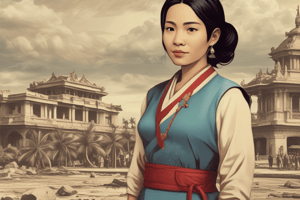Podcast
Questions and Answers
Which rebel group formed in the southern part of the country in the Philippines?
Which rebel group formed in the southern part of the country in the Philippines?
- National League for Democracy
- Abu Sayyaf
- New People's Army
- Moro National Liberation Front (correct)
What event led to the military government stepping down in Burma in 1988?
What event led to the military government stepping down in Burma in 1988?
- Pro-democracy protests
- Ne Win's resignation (correct)
- International sanctions
- Aung San Suu Kyi's election victory
What was the result of the 1990 multiparty elections in Burma?
What was the result of the 1990 multiparty elections in Burma?
- Aung San Suu Kyi was elected president
- The election was canceled due to violence
- The National League for Democracy won 80 percent of the seats (correct)
- The military government won a majority of seats
Who became the president of Burma in 2011 and made reforms?
Who became the president of Burma in 2011 and made reforms?
What was the outcome of the 1959-1990 period in Singapore?
What was the outcome of the 1959-1990 period in Singapore?
What was the result of the 1999 vote in East Timor?
What was the result of the 1999 vote in East Timor?
Who was the leader of Indonesia who put down rebellions and declared himself president in 1967?
Who was the leader of Indonesia who put down rebellions and declared himself president in 1967?
What was the outcome of the 1997-1998 period in Indonesia?
What was the outcome of the 1997-1998 period in Indonesia?
What was the date of the Declaration of Independence in the Philippines?
What was the date of the Declaration of Independence in the Philippines?
What was the condition set by the US for providing $620 million in war damage to the Philippines?
What was the condition set by the US for providing $620 million in war damage to the Philippines?
What was the period of Martial Law declared by Ferdinand Marcos?
What was the period of Martial Law declared by Ferdinand Marcos?
Who succeeded Ferdinand Marcos as President of the Philippines?
Who succeeded Ferdinand Marcos as President of the Philippines?
What was the consequence of the public outcry against Ferdinand Marcos?
What was the consequence of the public outcry against Ferdinand Marcos?
What was the restriction on Fidel Ramos' rule as President of the Philippines?
What was the restriction on Fidel Ramos' rule as President of the Philippines?
Flashcards are hidden until you start studying
Study Notes
Philippines
- The Philippines declared independence on July 4, 1946, and aimed to rebuild its economy and capital, Manila.
- The US provided $620 million in war damage but required the Philippines to approve the Bell Act, which allowed for free trade with the US with increasing tariffs.
- The Philippines approved the Bell Act, allowing the US to establish military and naval bases in the country, which many saw as a sign of American imperialism.
- The US left the Philippines in 1992.
- Ferdinand Marcos ruled the Philippines from 1965 to 1986, imposing an authoritarian regime and stealing money from the country.
- Marcos declared martial law from 1972 to 1981, and had his opponent Benigno Aquino assassinated.
- Corazon Aquino, Benigno's widow, challenged Marcos and led to his exile to Hawaii in 1986.
- In 1995, the Philippines recovered from the losses caused by Marcos, and a new constitution was established.
- Fidel Ramos ruled the Philippines from 1992 to 1998, with a limited six-year term, and negotiated with the US to lease military bases.
Philippines - Government vs. Rebels
- The southern part of the Philippines is home to Muslim Moros, who formed the Moro National Liberation Front (MNLF).
- In 1996, the MNLF agreed to a cease-fire with the government, but Abu Sayyaf, a division of MNLF, continued to fight.
- The government launched a military response to Abu Sayyaf, with support from the US.
Burma (Myanmar)
- Burma gained independence in 1948, and was renamed Myanmar in 1989.
- Ne Win established a military government in 1962, which continues to rule the country to this day.
- Aung San Suu Kyi became active in the National League for Democracy (NLD) in 1988, and won 80% of the seats in multiparty elections in 1990.
- However, the military government refused to recognize the result, and Suu Kyi was arrested and released several times.
- In 2010, Burma passed laws banning people who married a foreigner from holding political office, including Suu Kyi.
- In 2011, Thein Sein became president and made reforms, relaxing restrictions on Suu Kyi.
- In 2012, Suu Kyi ran for office, and the NLD won 43 seats out of 45, leading to the US lifting restrictions on Myanmar.
Malaysia and Singapore
- The Federation of Malaya was formed in 1957, uniting several lands and peoples.
- Singapore broke away from Malaysia in 1965 to become an independent city-state.
- Lee Kuan Yew ruled Singapore from 1959 to 1990, turning it into an important banking and trade center.
- Malaysia and Singapore built thriving economies.
Indonesia
- Sukarno led Indonesia's independence movement and tried to guide the nation towards democracy.
- Indonesia gained independence in 1949, and is home to many ethnic groups and a large Muslim population.
- Sukarno was unable to manage the economy, leading to inflation, and unable to unify the people.
- Suharto took over as president in 1967 and ruled until 1998, annexing East Timor in 1976.
- Suharto's rule was marked by little religious freedom, and he stepped down in 1998 after a financial crisis.
East Timor
- Indonesia ruled East Timor with violence since the 1970s.
- In 1999, the citizens of East Timor voted for independence in a UN-sponsored referendum.
- Pro-Indonesian forces used violence to try to stop the independence movement, but UN forces eventually brought peace.
- East Timor gained independence in 2002.
Studying That Suits You
Use AI to generate personalized quizzes and flashcards to suit your learning preferences.




